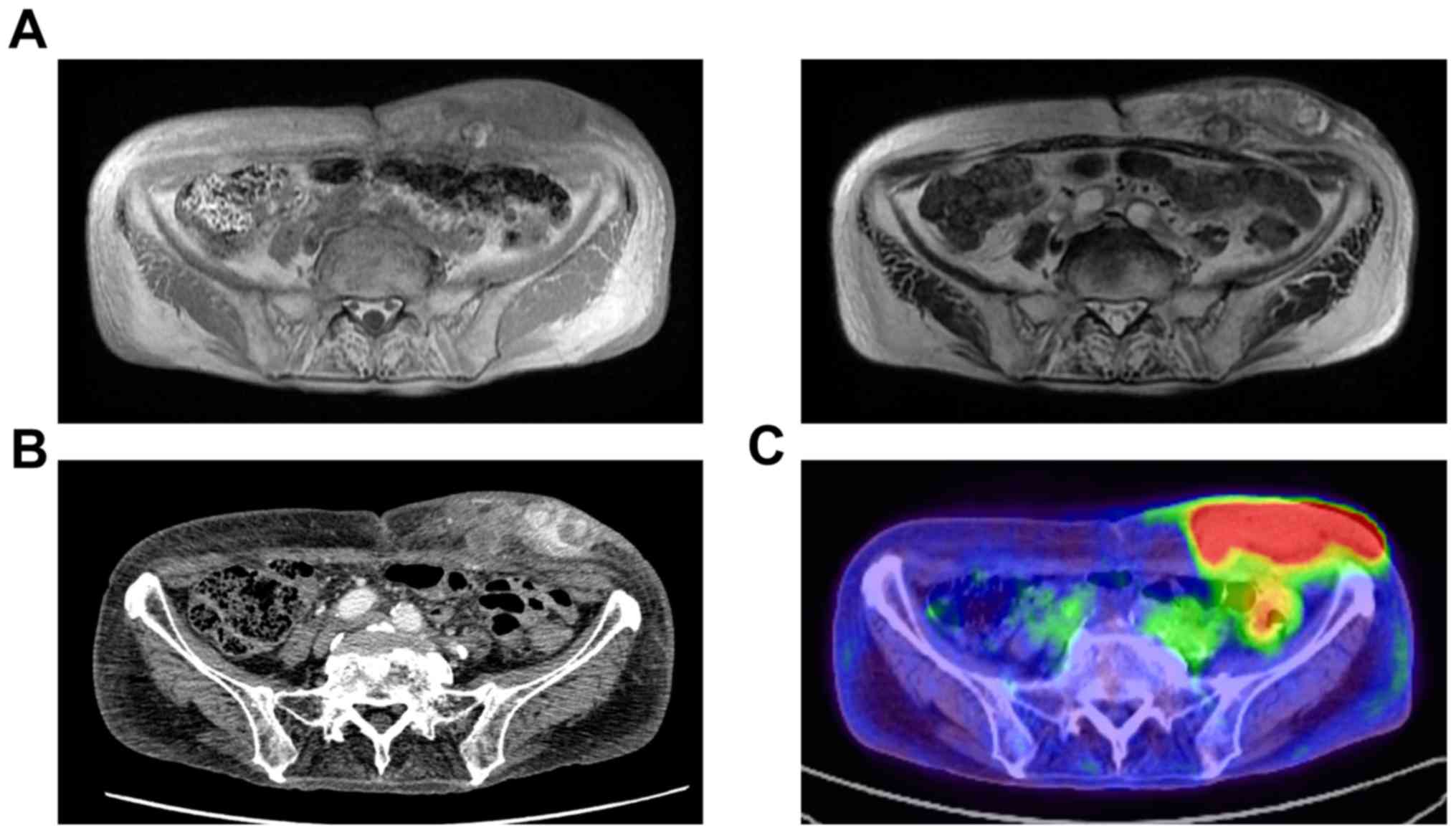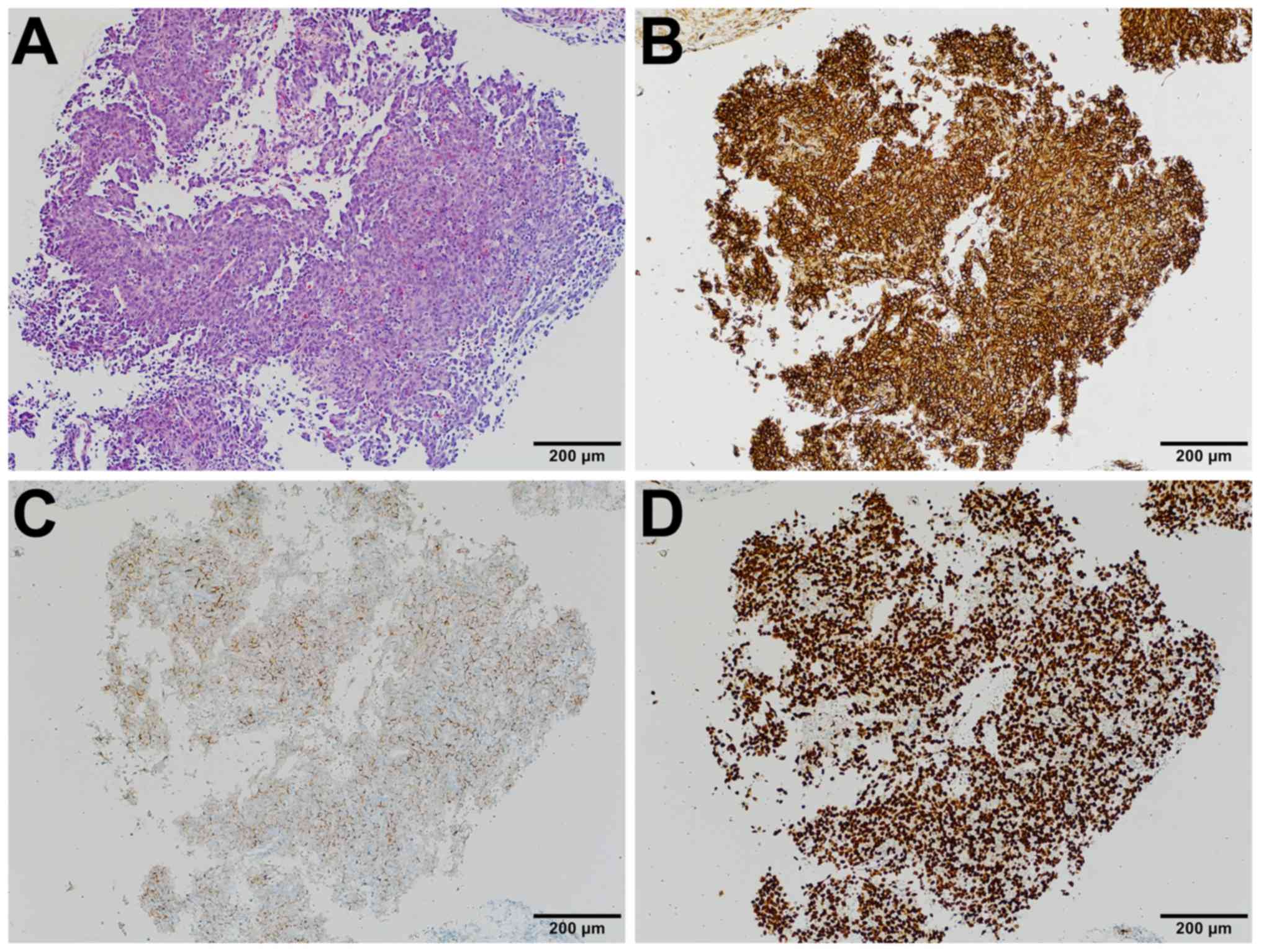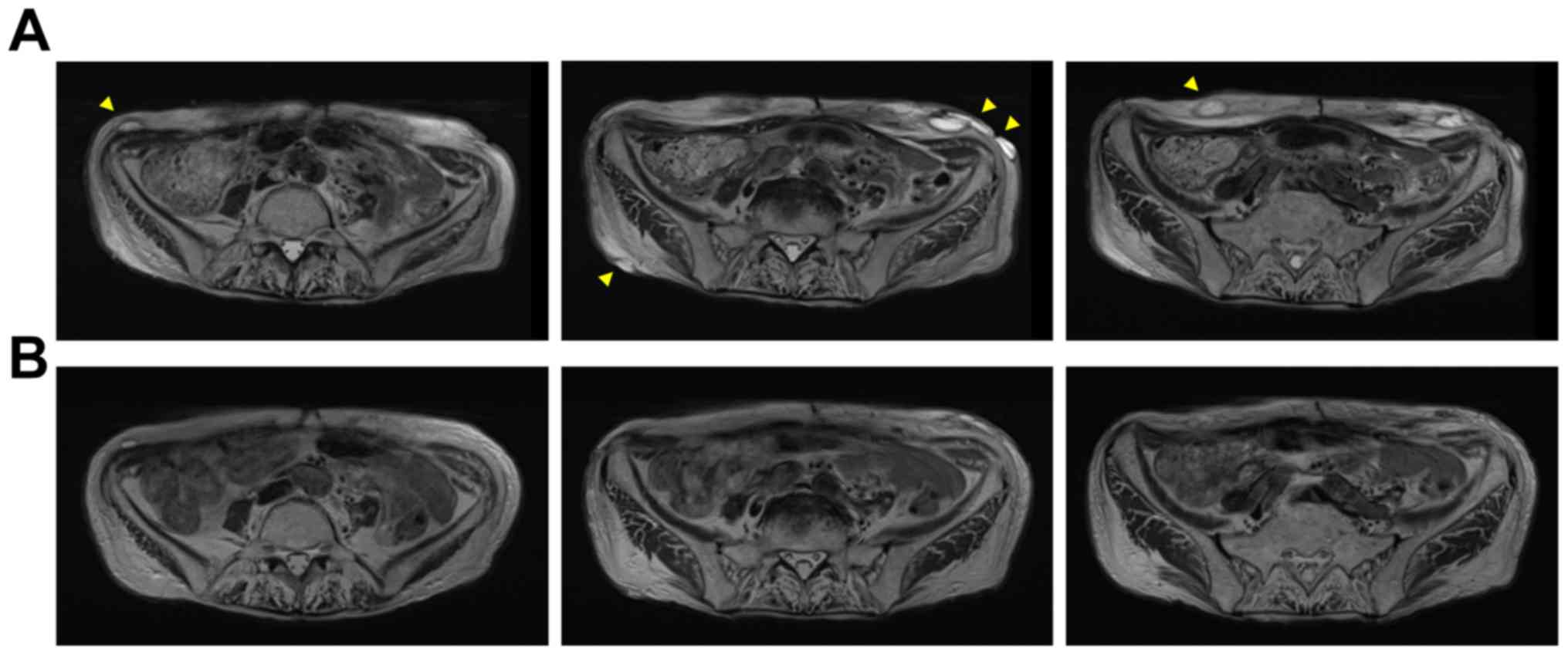|
1
|
Young RJ, Brown NJ, Reed MW, Hughes D and
Woll PJ: Angiosarcoma. Lancet Oncol. 11:983–991. 2010.PubMed/NCBI View Article : Google Scholar
|
|
2
|
Stewart FW and Treves N: Lymphangiosarcoma
in postmastectomy lymphedema; A report of six cases in
elephantiasis chirurgica. Cancer. 1:64–81. 1948.PubMed/NCBI View Article : Google Scholar
|
|
3
|
McHaffie DR, Kozak KR, Warner TF, Cho CS,
Heiner JP and Attia S: Stewart-treves syndrome of the lower
extremity. J Clin Oncol. 28:e351–e352. 2010.PubMed/NCBI View Article : Google Scholar
|
|
4
|
Towle MJ, Salvato KA, Budrow J, Wels BF,
Kuznetsov G, Aalfs KK, Welsh S, Zheng W, Seletsky BM, Palme MH, et
al: In vitro and in vivo anticancer activities of synthetic
macrocyclic ketone analogues of halichondrin B. Cancer Res.
61:1013–1021. 2001.PubMed/NCBI
|
|
5
|
Jordan MA, Kamath K, Manna T, Okouneva T,
Miller HP, Davis C, Littlefield BA and Wilson L: The primary
antimitotic mechanism of action of the synthetic halichondrin E7389
is suppression of microtubule growth. Mol Cancer Ther. 4:1086–1095.
2005.PubMed/NCBI View Article : Google Scholar
|
|
6
|
Okouneva T, Azarenko O, Wilson L,
Littlefield BA and Jordan MA: Inhibition of centromere dynamics by
eribulin (E7389) during mitotic metaphase. Mol Cancer Ther.
7:2003–2011. 2008.PubMed/NCBI View Article : Google Scholar
|
|
7
|
Sharma A and Schwartz RA: Stewart-treves
syndrome: Pathogenesis and management. J Am Acad Dermatol.
67:1342–1348. 2012.PubMed/NCBI View Article : Google Scholar
|
|
8
|
Taswell HF, Soule EH and Coventry MB:
Lymphangio-sarcoma arising in chronic lymphedematous extremities.
Report of thirteen cases and review of literature. J Bone Joint
Surg Am. 44-A:277–294. 1962.PubMed/NCBI
|
|
9
|
Grobmyer SR, Daly JM, Glotzbach RE and
Grobmyer AJ III: Role of surgery in the management of
postmastectomy extremity angiosarcoma (stewart-treves syndrome). J
Surg Oncol. 73:182–188. 2000.PubMed/NCBI View Article : Google Scholar
|
|
10
|
Kerchner K, Fleischer A and Yosipovitch G:
Lower extremity lymphedema update: Pathophysiology, diagnosis, and
treatment guidelines. J Am Acad Dermatol. 59:324–331.
2008.PubMed/NCBI View Article : Google Scholar
|
|
11
|
Judson I, Verweij J, Gelderblom H,
Hartmann JT, Schöffski P, Blay JY, Kerst JM, Sufliarsky J, Whelan
J, Hohenberger P, et al: Doxorubicin alone versus intensified
doxorubicin plus ifosfamide for first-line treatment of advanced or
metastatic soft-tissue sarcoma: A randomised controlled phase 3
trial. Lancet Oncol. 15:415–423. 2014.PubMed/NCBI View Article : Google Scholar
|
|
12
|
Fata F, O'Reilly E, Ilson D, Pfister D,
Leffel D, Kelsen DP, Schwartz GK and Casper ES: Paclitaxel in the
treatment of patients with angiosarcoma of the scalp or face.
Cancer. 86:2034–2037. 1999.PubMed/NCBI
|
|
13
|
Fury MG, Antonescu CR, Van Zee KJ, Brennan
MF and Maki RG: A 14-year retrospective review of angiosarcoma:
Clinical characteristics, prognostic factors, and treatment
outcomes with surgery and chemotherapy. Cancer J. 11:241–247.
2005.PubMed/NCBI View Article : Google Scholar
|
|
14
|
Skubitz KM and Haddad PA: Paclitaxel and
pegylated-liposomal doxorubicin are both active in angiosarcoma.
Cancer. 104:361–366. 2005.PubMed/NCBI View Article : Google Scholar
|
|
15
|
Schlemmer M, Reichardt P, Verweij J,
Hartmann JT, Judson I, Thyss A, Hogendoorn PC, Marreaud S, Van
Glabbeke M and Blay JY: Paclitaxel in patients with advanced
angiosarcomas of soft tissue: A retrospective study of the EORTC
soft tissue and bone sarcoma group. Eur J Cancer. 44:2433–2436.
2008.PubMed/NCBI View Article : Google Scholar
|
|
16
|
Penel N, Bui BN, Bay JO, Cupissol D,
Ray-Coquard I, Piperno-Neumann S, Kerbrat P, Fournier C, Taieb S,
Jimenez M, et al: Phase II trial of weekly paclitaxel for
unresectable angiosarcoma: The ANGIOTAX study. J Clin Oncol.
26:5269–5274. 2008.PubMed/NCBI View Article : Google Scholar
|
|
17
|
Nagano T, Yamada Y, Ikeda T, Kanki H, Kamo
T and Nishigori C: Docetaxel: A therapeutic option in the treatment
of cutaneous angiosarcoma: Report of 9 patients. Cancer.
110:648–651. 2007.PubMed/NCBI View Article : Google Scholar
|
|
18
|
Stacchiotti S, Palassini E, Sanfilippo R,
Vincenzi B, Arena MG, Bochicchio AM, De Rosa P, Nuzzo A, Turano S,
Morosi C, et al: Gemcitabine in advanced angiosarcoma: A
retrospective case series analysis from the Italian rare cancer
network. Ann Oncol. 23:501–508. 2012.PubMed/NCBI View Article : Google Scholar
|
|
19
|
Leu KM, Ostruszka LJ, Shewach D, Zalupski
M, Sondak V, Biermann JS, Lee JS, Couwlier C, Palazzolo K and Baker
LH: Laboratory and clinical evidence of synergistic cytotoxicity of
sequential treatment with gemcitabine followed by docetaxel in the
treatment of sarcoma. J Clin Oncol. 22:1706–1712. 2004.PubMed/NCBI View Article : Google Scholar
|
|
20
|
Schoffski P, Chawla S, Maki RG, Italiano
A, Gelderblom H, Choy E, Grignani G, Camargo V, Bauer S, Rha SY, et
al: Eribulin versus dacarbazine in previously treated patients with
advanced liposarcoma or leiomyosarcoma: A randomised, open-label,
multicentre, phase 3 trial. Lancet. 387:1629–1637. 2016.PubMed/NCBI View Article : Google Scholar
|
|
21
|
Demetri GD, Schoffski P, Grignani G, Blay
JY, Maki RG, Van Tine BA, Alcindor T, Jones RL, D'Adamo DR, Guo M
and Chawla S: Activity of eribulin in patients with advanced
liposarcoma demonstrated in a subgroup analysis from a randomized
phase III study of eribulin versus dacarbazine. J Clin Oncol.
35:3433–3439. 2017.PubMed/NCBI View Article : Google Scholar
|
|
22
|
Kawai A, Araki N, Naito Y, Ozaki T,
Sugiura H, Yazawa Y, Morioka H, Matsumine A, Saito K, Asami S and
Isu K: Phase 2 study of eribulin in patients with previously
treated advanced or metastatic soft tissue sarcoma. Jpn J Clin
Oncol. 47:137–144. 2017.PubMed/NCBI View Article : Google Scholar
|
|
23
|
Wada N, Uchi H and Furue M: Case of
angiosarcoma of the scalp successfully controled by eribulin. J
Dermatol. 45:116–117. 2018.PubMed/NCBI View Article : Google Scholar
|
|
24
|
Inagaki C, Shimoi T, Okuma H, Kitano A,
Shimomura A, Noguchi E, Kodaira M, Yunokawa M, Yonemori K, Shimizu
C, et al: A case of heavily pretreated metastatic cardiac
angiosarcoma treated successfully using eribulin. Anticancer Drug.
29:97–101. 2018.PubMed/NCBI View Article : Google Scholar
|
|
25
|
Kobayashi E, Naito Y, Asano N, Maejima A,
Endo M, Takahashi S, Megumi Y and Kawai A: Interim results of a
real-world observational study of eribulin in soft tissue sarcoma
including rare subtypes. Jpn J Clin Oncol. 49:938–946.
2019.PubMed/NCBI View Article : Google Scholar
|
|
26
|
Fujisawa Y, Fujimura T, Matsushita S,
Yamamoto Y, Uchi H, Otsuka A, Funakoshi T, Miyagi T, Hata H, Gosho
M, et al: The efficacy of eribulin mesylate for patients with
cutaneous angiosarcoma previously treated with taxane: A
multicentre prospective observational study. Br J Dermatol 2020
(Epub ahead of print).
|

















